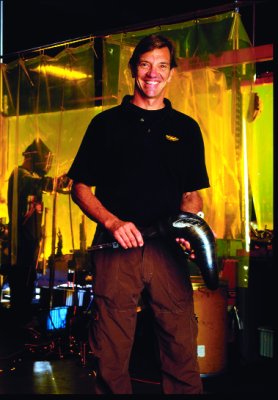BIG THINKER: PIONEER–DONNIE EMLER
DONNIE EMLER CAN RIGHTFULLY BE CONSIDERED THE FOUNDING FATHER OF THE MOTOCROSS HOP-UP BUSINESS.
Very few people can say they got in on the ground floor of the American motocross movement. The list of people and companies who were around when motocross was in its infancy is short, but distinguished. Donnie Emler is one who makes the list. He started racing in 1967 and spent until 1973 chasing the professional motocross dream. In the process, he started making mods to his own race bikes. Other racers noticed Donnieƒ??s workmanship and asked him to hop-up their bikes. Soon Donnie was spending more time working on his competitorƒ??s bikes than he was on his own. At that point, Donnie decided it was time to turn his fledgling hop-up shop into a full-time business. Despite what people may believe, FMF is an acronym for Flying Machine Factory. “Those Magnificent Men in their Flying Machines” was Donnieƒ??s favorite movie in 1973.
It didnƒ??t take long for FMF to taste its first success at the AMA National level. Monark rider Marty Smith was the first fast Pro to ride for the newly minted FMF team, and, in 1974, when Smith signed on with Team Honda, FMF was onboard his bike when he won the first-ever AMA 125 National Championship. The red-tipped stinger was an FMF signature in the early ƒ??70s. Smith would go on to repeat in 1975, and FMF would get the reputation for building some of the fastest Honda Elsinores on the planet. In 1976, FMF switched their loyalty to building Suzukis and continued with RMs through 1977 (believe it or not, Jeff Ward raced the Nationals for FMF his first season on a Suzuki).
Donnieƒ??s reputation as a wild man has often been overstated, but not by Donnie. He admits that he wasnƒ??t the best businessman in the formative days of motocross, and in 1983 Donnie lost control of FMF. It ended up in the hands of the late Al Baker. Donnie was devastated, but he pulled himself up by his bootstraps and started over with a new hop-up company named Roost Factory (RF). It too ended up in someone elseƒ??s hands. But Donnie never gave up, and in 1985, he retook the reins at FMF and started a success story that is still going in 2005.
After all of FMFƒ??s successes in the 1970s and the downtimes in the ƒ??80s, FMF had their biggest breakthrough in 1988 with the release of their plated exhaust pipes. While many diehard motocrossers couldnƒ??t stand the sight of a chrome exhaust pipe, the buying public couldnƒ??t resist the appeal of a pipe that wouldnƒ??t rust (after all, who really likes to spend countless hours with WD40 and a Scotch-Brite pad?). AMA National Pros continued to use raw metal pipes, but FMF proved that local riders have a more practical side.

Another brainstorm Emler had was the “Try before you buy” philosophy. At select races, FMF would send a truck full of pipes and a bevy of mechanics to fit them on the bike of any rider who wanted to try them. If the rider liked the pipe, he could buy it on the spot. At the same time, FMF began to expand its product lineƒ?”going beyond exhaust pipes into everything from porting to suspension services to hard parts. Eventually, Donnie saw the folly of trying to be everything to every man and returned FMF to its hop-up roots.
Prior to 1998, FMF was primarily a two-stroke pipe company. They had carved out quite a business making indestructible two-stroke pipes, but they were quick to address the exploding four-stroke market with their popular Factory 4 exhaust. And, when sound became an issue, FMF introduced the Q series, which seriously quieted four-strokes without robbing valuable horsepower.
You probably donƒ??t know this, but FMF actually made bicycles back in the 1970s, and now those antique bikes are highly sought-after collectorsƒ?? items. Today, FMF again offers a complete line of bicycles for BMXers to get their feet wet on before taking the plunge with a two-wheeled vehicle with a motor.
Donnie Emler, best known as “Uncle Donnie” to the faithful, can rightfully be considered the founding father of the motocross hop-up business. He started by working on his own bikes, then making a few parts for friends, and over time building it into a powerhouse empire.
How serious is Donnie about making the best aftermarket products possible? At one point Donnie had a studio apartment built at FMF headquarters so that he could work around the clock. Things havenƒ??t changed much. Donnie still spends almost every waking moment in the dyno room trying to squeeze out a few more horsepowerƒ?”just like he did 35 years ago. o




Comments are closed.